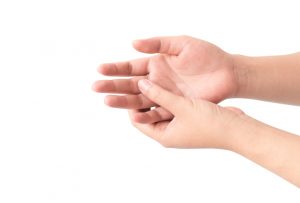You are probably aware of the many different ways the cold weather can affect your health. Conditions such as heart attack, asthma, and arthritis can all worsen when we are exposed to the cold, but did you know that the cold can also affect blood supply to your skin, resulting in a condition known as Raynaud’s disease.
In Raynaud’s disease, smaller arteries that supply blood to your skin become narrow, limiting blood circulation to affected areas, most commonly the fingers and toes.
Signs and symptoms of Raynaud’s disease include:
- Cold fingers or toes
- Color changes in your skin in response to cold or stress
- Numb, prickly feeling or stinging pain upon warming or stress relief
During an attack of Raynaud’s, affected areas of your skin typically first turn white. Then, they often turn blue and feel cold and numb. As you warm-up and circulation improves, the affected areas may turn red, throb, tingle or swell. After warming, it can take approximately 15 minutes for normal blood flow to return to the area.
Although Raynaud’s most commonly affects your fingers and toes, it can also affect other areas of your body, such as your nose, lips, ears and even nipples.
Cold temperatures are most likely to trigger an attack. However, exposure to cold, such as putting your hands in cold water, taking something from a freezer or being in cold air are also common triggers. For some people, emotional stress can also trigger an episode.
There are two main types of the condition.
- Primary Raynaud’s -Also called Raynaud’s disease, this most common form isn’t the result of an associated medical condition. It can be so mild that many people with primary Raynaud’s don’t seek treatment.
- Secondary Raynaud’s -Also called Raynaud’s phenomenon, this form is caused by an underlying problem. Although secondary Raynaud’s is less common than the primary form, it tends to be more serious. In rare cases, diminished blood circulation to your fingers or toes could cause tissue damage.
Treatment of Raynaud’s disease depends on its severity and whether you have other health conditions. For most people, Raynaud’s disease isn’t disabling, but it can affect their quality of life.
To help prevent a Raynaud’s attack, bundle up when heading outdoors. Wear a hat, scarf, face mask, and a snug fitting coat to prevent the cold air from circulating onto your skin. You should also wear heavy boots and two layers of socks and gloves if necessary. Also take precautions indoors. Air conditioners can trigger a reaction so be sure to set yours to a comfortable temperature. Use insulated drinking glasses when consuming a cold beverage as well.
See your doctor right away if you have a history of severe Raynaud’s and develop a sore or infection in one of your affected fingers or toes.
To schedule an appointment with a doctor at Flushing Hospital’s Ambulatory Care Center, please call 718-670-5486.
All content of this newsletter is intended for general information purposes only and is not intended or implied to be a substitute for professional medical advice, diagnosis or treatment. Please consult a medical professional before adopting any of the suggestions on this page. You must never disregard professional medical advice or delay seeking medical treatment based upon any content of this newsletter. PROMPTLY CONSULT YOUR PHYSICIAN OR CALL 911 IF YOU BELIEVE YOU HAVE A MEDICAL EMERGENCY.

